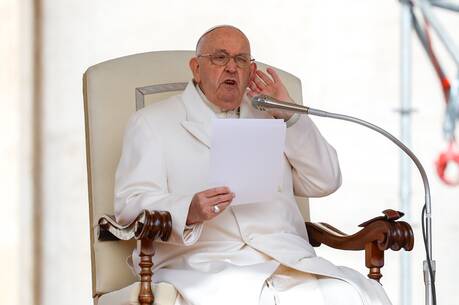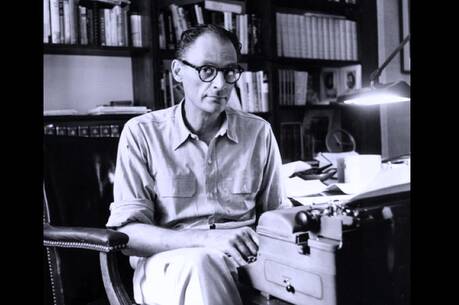View of Jesus
Your Of Many Things column on March 17 referred to Jesus Before Christianity, by Albert Nolan, O.P. For six years in the late 1970’s, my family and I lived in Cape Town, South Africa, during which I did a three-year certificate program at the Kolbe School of Theology.
One of our three main teachers was Father Nolan. We had the privilege of reading Jesus Before Christianity the year before it was published. It was and is still a refreshing, provocative view of Jesus, which dramatically deepened my earlier beliefs and made them much more real. That change has persisted. My memory is that he had a similar impact on the other participants.
What a wonderful difference a single individual can make!
Terry J. van der Werff
Devon, Pa.
American Church
I was saddened by Carol K. Coburn’s haughty and dismissive review of the book Sisters: Catholic Nuns and the Making of America, by John J. Fialka (3/3). In her haste to claim the book does not reflect much of the relevant and recent scholarship on nuns, including, one presumes, some of her own work, she misses the basic point of the book.
Among the recent popular histories of the American Catholic Church, I don’t know of any that give religious women as much as a chapter for their role in building the church in America or the galaxies of hospitals, schools and other institutions that stand as lasting but mute testimony to their contributions.
The unfortunate truth is that most people are not aware of the point that Mr. Fialka makes, which is that for most of its history in the U.S. the face of the church that many people saw was that of a woman. For every priest there were four women entering the church’s religious orders.
Because many of these women are no longer at their posts, and because much of the academically correct work Ms. Coburn prefers has not attracted the interest of mainstream writers of church history, it is not unusual to find educated Catholics asking why they should feel obliged to contribute to the retirement needs for elderly sisters.
I think your readers will find that Mr. Fialka’s book is much more than what Ms. Coburn condescendingly describes as well-meaning. It is packed with exciting, well-documented and well-told stories that will help Americansnot just Catholicsunderstand how Catholic nuns helped to advance the mission of the church in American culture. Without their mighty works and lessons of self-sacrifice on the frontiers, during the Civil War, in the civil rights movement; without their quiet hopefulness and perseverance in countless classrooms and hospital corridors, we would be a different and spiritually poorer nation.
Francis J. Butler
President, Foundations and Donors Interested in Catholic Activity
Washington, D.C.
Wonderful Gift
Your Christmas 2002 issue arrived by sea mail last evening! It was a wonderful gift to help me celebrate my patron saint’s feast day. I class Paul Mariani’s poem on St. Joseph with G. K. Chesterton’s. No higher praise can I give. And the icon, Shadow of the Father, by William Hart McNichols, I will treasure. I have put both poem and icon up on the wall of my room. They will be an inspiration as I, Joseph, try to be a shadow of the Father to Christ-in-the-poor here in the Himalayas.
J. M. Abraham, S.J.
Darjeeling, India
Cooperation
Robert P. Maloney, C.M., (3/10) encourages those people in the church who waver on the importance of the laity to read the letter of Paul to the Romans (Rom 16:4) regarding the indebtedness of the Gentile communities to the married couple Priscilla and Aquila.
Father Maloney asks that the Catholic lay person of the 21st century should be capable of cooperating with other members of the church. For that to happen, other members of the church, including bishops, would also have to be willing to cooperate with the laity. It was coincidental that in that same issue of America (Signs of the Times) Kathleen L. McChesney, director of the U.S. bishops’ Office for Child and Youth Protection was quoted as saying she thought bishops should allow Voice of the Faithful to meet in the churches of their dioceses.
How can it be possible for the laity of the 21st century to become like Priscilla and Aquila if most bishops refuse to relinquish their power and authority on such a minor issue as allowing the laity to use our facilities for meetings? Do you think that Paul would have refused Priscilla and Aquila from using the facilities of the early church?
Gerald F. Holland
Old Lyme, Conn.
Heave a Sigh
The article Friendship Is a Prayer, by Greg Kandra, (3/17) was a fine one, except for the phrase light up a smoke in the last paragraph.
It is not necessary to create an image advocating smoking, with all that is known about its non-prayerful, harmful effects on health. I regretted seeing that in your publication.
Joanne Bobek
Orwigsburg, Pa.
Style Today
Thank you for publishing The Style of Vatican II, by John W. O’Malley, S.J., (2/24). Its insights are uniformly sound, and the author has thrown contemporary light on the style and tone (as well as the sense and spirit) of the great council. It is better than a step-by-step response to Cardinal Avery Dulles’s treatment of the councilalthough that kind of response to Cardinal Dulles is also needed. Father O’Malley has grasped and expressed well the conciliar, open-ended development and progress that should be constitutive of the church style today.
(Msgr.) Frederick R. McManus
Boston, Mass.
Active Contemplation
This response is intended as an encouragement to those who, like Sally Cunneen (3/3), find it difficult, even in private, simultaneously to pray the rosary prayers and meditate on the mysteries.
I remember Father Louis (Thomas) Merton telling us Trappist-Cistercian scholastics at Gethsemani some 40 years ago that he prayed the rosary daily in honor of the mysteries (he did not elaborate what that meant for him). For myself, I have developed the habit of beginning by communing with the goodness of God on a deep experiential level. Then, when praying the mysteries, I experience them as ways in which God reveals this goodness. Mary and Joseph are models of responsethis in my gut, not in my head.
So here is God’s goodness revealed in the Incarnation and the events of Jesus’ childhood and, again, in his suffering and death. (How marvelous that his goodness led him to become so vulnerable!) When Jesus dies on the cross, my old self seems to die with him and when he rises and is glorified (goodness vindicated), my true self (Merton’s term) seems liberated with new strength and purity of heart. As Our Lady is assumed into heaven and crowned, identified with her, my heart seems to share her glory.
My point is that, for some of us moderns, rosary meditation continues to be not only possible, but a useful way to evoke a surrender of mind and heart to God in active contemplation. It would be regrettable if the difficulties Ms. Cunneen mentions should discourage anyone, including her, from the creative effort needed to develop competence in a form of prayer found so fruitful over the centuries.
(Rev.) Don Derivaux
Vicksburg, Miss.
Inclusive
The article Lay Catholics in the 21st Century, by Robert P. Maloney, C.M. (3/10), provided an excellent thumbnail sketch of the modern Catholic. I particularly liked what the author said about the relationship between prayer and action, and how the one needs the other. I think, however, that he missed a couple of points.
When Father Maloney wrote that the modern Catholic would be profoundly lay and went on to quote Evangelii Nuntiandi describing the family as the domestic church, he failed to mention that many of those families would have divorced parents, and that many of the children would be stepchildren, and others would be single parents or simply single with no children. These are facts of modern life. Catholics in such situations have a role to play in the church every bit as important as the traditional nuclear family. They should not necessarily be considered as special groups with particular pastoral needs.
He points out rightly that Catholics today are, in general, well schooled and well educated and can contribute their expertise and talents in no small measure to the church. But he should also have said that such Catholics are increasingly thinking for themselves and coming to their own diverse conclusions, even in cases when the pope and/or the bishops have made clear statements. The church in the United States, as elsewhere, has done and continues to do an excellent job offering educational opportunities at all levels to Catholics, but ministering to these highly educated and informed Catholics is a different matter.
It is true that they will be multiracial, but they will also be inclusive in terms of gender, age, disability, sexual orientation, diversity of religious viewpoints, etc.
Antony M. Visocchi
Summit, N.J.
Friendship
The March 17 issue of America gave us the wonderfully human reflections of a man living the simple Christian life. In this world today of untold distractions, to know Christ is no little achievement
In Friendship Is a Prayer, Greg Kandra tells us of his feelings of guilt when, during his retreat to the Abbey of Gethsemani, he chooses to share the companionship of a friend rather than respond to the chapel bell for evening prayer. He decides that the simple liturgy of friends is prayer at its best. So I say, thank you for reminding us that when we respect our friends we are responding to Christ’s command to love one another.
Jack A. Artale
Doylestown, Pa.
Handicaps
I have read with interest many of George Weigel’s recent defenses of the current war with Iraq, including the most recent in America (3/31). I believe his case, though articulate and reasoned, suffers from several significant handicaps. The first is the confusion of conservative politics and moral reasoning. I suspect that Weigel first makes his conclusions on political grounds, and only then turns to church teaching for support. Second, Weigel’s argument fails to take sufficiently into account recent Catholic social teaching (especially that of Pope John Paul II, whose mind he purportedly knows so well), where there is indeed a stronger presumption against violence precisely because of the existence of weapons of mass destruction. Finally, I believe that Weigel is somewhat naïve in presuming the good intentions of our government and in claiming for it a certain moral high ground that makes war not only acceptable, but our duty. Pope John Paul II is no slouch when it comes to just war reasoning, and is less affected by American political agendas. We should listen to him.
Mark Mossa, S.J.
Tampa, Fla.
Confrontation
One element missing from the article by Drew Christiansen, S.J., on the just war theory (3/24) is a consideration of the virtue of prudence. Prudence is exercised in applying just war criteria in the difficult gray areas of human decision making. In such situations, prudent Christians sometimes come to differing decisions as to whether a war is just.
Just war criteria have developed over the centuries. The contemporary reality of terrorism forces us to look at these criteria again. Today self-defense against terrorism may call for military interventions. We need to develop further criteria for just interventions in self-defense.
Father Christiansen believes that preventive war is a dangerous innovation. An even greater innovation in Catholic thought is a de facto pacifism. Such pacifism could lead to infinite diplomatic initiatives but no serious confrontation with evil.
John W. Crossin, O.S.F.S.
Washington, D.C.







